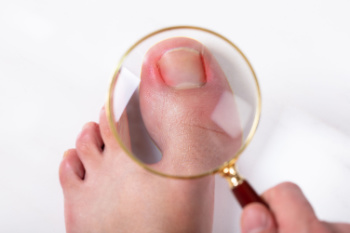Stages and Symptoms of an Ingrown Toenail

Ingrown toenails occur when the edge of a toenail grows into the surrounding skin, causing pain and inflammation. In stage one, the toe is swollen and tender with mild pain. Stage two involves increased pain, redness, and possible infection with pus. In stage three, the inflammation is severe, and there is significant infection and overgrowth of skin tissue. Symptoms progress from discomfort and redness to intense pain and oozing fluid. Preventing ingrown toenails involves proper nail care, consisting of trimming toenails straight across without rounding the corners, avoiding cutting them too short, and wearing shoes that fit well to reduce pressure on the toes. Maintaining good foot hygiene and regularly inspecting the feet can also help prevent the development of ingrown toenails and the complications associated with them. If you have developed an ingrown toenail, there may be significant pain, and it is suggested that you consult a chiropodist who can effectively treat this condition.
Ingrown toenails may require medical attention. If you have significant pain or notice signs of infection from an ingrown toenail, please consult with one of the chiropodists from The Footcare Centre. Our chiropodists will assess your condition and provide you with quality foot and ankle treatment.
What Is an Ingrown Toenail?
An ingrown toenail occurs when the edges of a toenail grow into the surrounding skin. The toenails of the big toe are usually affected, however, an ingrown toenail can happen on any toe. Sometimes, the area can become infected leading to potentially serious complications. The ingrown toenail may be caused by improper trimming of the toenail, wearing ill-fitting shoes, or injury to the nail.
Symptoms
The symptoms of an ingrown toenail include:
Pain
Swelling
Redness
Warmth
Pus or drainage from the affected nail or a fever may indicate an infection of the area.
Treatment
Treatment depends on the severity of the ingrown toenail. In less severe cases, home treatment may be adequate. Soaking the affected foot in warm water and gently lifting the nail from the skin with a piece of clean cotton can help. In more severe cases, you may need to use topical or oral antibiotics to treat an infection. Surgical removal of the ingrown toenail may be required if more conservative treatments fail.
Ingrown toenails may be prevented by wearing well-fitted shoes and properly trimming the toenails. Toenails should be trimmed straight across and not too short when using nail clippers.
If you have any questions, please feel free to contact our office located in . We offer the newest diagnostic and treatment technologies for all your foot care needs.
